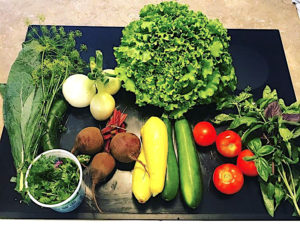Community Supported Agriculture (CSA) is a farming practice that promotes a shared commitment by consumers and growers to build a more local and equitable agricultural system. Introduced in the mid-80s, CSAs are
“a community of individuals who pledge support to a farm operation so that the farmland becomes, either legally or spiritually, the community’s farm, with the growers and consumers providing mutual support and sharing the risks and benefits of food production.” (USDA, Defining Community Supported Agriculture)
The practice allows growers to focus on land stewardship while maintaining productive and profitable small farms. Most CSA growers use organic or sustainable farming methods, and strive to provide fresh, high-quality foods.
Members, also known as “shareholders” of the farm, purchase subscriptions in advance of the growing season which in turn covers the upfront costs of the farm’s operations (such as purchasing seeds, irrigation, etc.). It provides growers with working capital when they need it rather than waiting for the harvest to generate revenue. Members also share in the risks of farming, including poor harvests due to unfavorable weather or pests, with the understanding that a refund will not be issued in the event that no crops are harvested. By direct sales to community members, growers receive better prices for their crops, gain financial security, and are relieved of much of the burden of marketing when they need to be working in the field. In return, members receive shares of the farm’s bounty throughout the growing season.
How They Work
CSA shares offer a diversity of vegetables, fruits, and herbs in season, often varieties that can only be found or grown locally and don’t exist in the produce aisle of your grocery store. Some even provide options for shares in eggs, milk, meat, cheese, and baked goods (add-on shares are often provided through partnerships with other local producers/food businesses). Subscriptions range in size of delivery and number of deliveries (ie. options for small or large shares or bi-weekly pick-ups). Winter vegetable shares, if offered, may be distributed just once a month due to lower volume and selection available (think storage and root crops like squash, carrots, beets, and potatoes!). However, meat and dairy CSAs may run all year as these products are less seasonal.
Pricing: Share price is calculated based by dividing the total operating costs (including the owner’s labor, management, and any debt service related to the enterprise) by the number of shareholders. CSAs sometimes offer working shares, where members work in exchange for a reduced price on their seasonal subscription. CSA shares average anywhere from 10-25 lbs of produce a week (or more, depending on the season!), at an average cost of $20-$40/week for the share. Organic produce at the grocery store can easily cost four times as much.
Distribution: Crops are typically harvested within 24-hours before it is distributed. Members are often given options of when to pick up their share at the farm or given a designated “pick up” location in a central area or city. Recently institutions and places of employment have arranged partnerships with CSAs offering on-site delivery as a benefit for their employees (some employers even offer vouchers for participating!).
Economic Impact of a CSA
Selling directly to consumers remains one of the main streams of revenue for produce farmers. In 2015, $3 billion in direct-to-consumer sales were made which accounted for 35% of total sales by farms growing food for consumption. Of that, 7,400 farms sold products directly to consumers through a CSA arrangement which accounted for $226 million (7%) of the $3 billion (USDA, Local Foods Marketing Survey, 2015).
Even as a small fraction of the farm’s sales, CSAs provide economic security from these guaranteed sales. According to a 2017 USDA report, 58% of CSA managers surveyed indicated that the CSA accounts for at least half of all their farm sales. The majority also stated that over time, their overall profit from CSAs were increasing (USDA AMS, Community Supported Agriculture: New Markets for Changing Markets). The CSA model also frees up time for the farmer doing direct to consumer sales at markets, which are time intensive, unpredictable, and harder to plan for. Moreover, CSAs ensure that money is kept within the community, spent locally, and strengthens local food systems which have proven economic and health benefits in a community
Lifestyle/Health Impact
CSAs are about strengthening individual health and a sense of community. They offer the opportunity to reconnect with rhythms of nature by eating produce when it is in season and participating directly in food production. According to a study by the University of Kentucky, CSA shareholders exhibited a strong shift away from processed foods for meals and snacks and an increase in food preparation expertise.
Many CSA farms take on the additional task of helping to educate their customers and communities in how to shift eating habits to a more seasonal diet. Shareholders are often introduced to fruits and vegetables they have little experience in preparing. To help with waste and education, farmers often prepare newsletters with progress in the garden, recipes and suggestions on storing produce, and upcoming social events at the farm. Some CSAs also take on composting shareholders’ food scraps or host events on the farm for shareholders.
The Future of CSAs
According to the USDA, after a surge in CSA numbers in the 2000’s, the number of CSA farms are now in decline. From 2012 to 2015, the number of CSA farms decreased by 41%.
What is contributing to the decline of CSAs? They rely on customer retention. While attrition is expected, CSAs are reporting fewer renewals each year. One of the biggest threats to the CSA model has been the growth of meal-kit delivery services like Blue Apron and Hello Fresh that tout fresh and healthy ingredients (but don’t source from “local” farms due to their scale). The entrance of Amazon into the grocery delivery market with its acquisition of Whole Foods has also been a major disruptor to the fresh produce industry, hitting local farmers hard as organic fresh produce can now be delivered to doorsteps rather than at pick-up and drop-off points common among CSAs. In response, grocery delivery services have emerged at every major national supermarket, crowding the fresh produce market even more. These delivery companies offer convenience, and ease of access to healthy foods but they rarely prioritize local ingredients and the small farms that grow them.
In order to maintain relevance, CSA farms are shifting their models to adapt to their customers preferences for convenience and customization. New products, season extensions, multi-farm collaborations, and innovative aggregation and delivery strategies are among the current trends reshaping the CSA business. Platforms like Harvie are helping small farms access more customers by aggregating their products with other regional farmers and allowing consumers to customize their weekly boxes.
CSA farms are also building relationships with community institutions that can subsidize subscriptions to increase options for low-income families — such as food banks, senior centers, and churches. (While Farmer’s Markets can accept SNAP benefits, CSAs have not yet been approved.) Another nascent market for CSAs has been within the healthcare sector where doctors can prescribe CSA shares to high-risk patients to improve their health or treat diet-related diseases.
How to Sign-Up
February 22 is National CSA Sign-Up Day! Find a CSA near you on the CSA Directory, the USDA listing, or conduct an online search to find one in your area. Most CSAs recommend signing up by spring so farms can plan for the growing season, and because subscriptions are limited and they often sell out.
Resources to learn more: USDA Community Supported Agriculture




